I don’t know about you, but I always look for plants that serve more than one purpose in my garden.
Don’t get me wrong, I love pretty flowers, but I think they are even better when they are edible, medicinal, or attract beneficial pollinators.
So, when my friend brought me some pigeon pea seeds, my first question was- what is it good for? What I learned really surprised me- there are so many uses!
But first, let’s talk about how you grow it.
Identification
Pigeon Pea, Cajanus cajan, has many different names throughout the world.
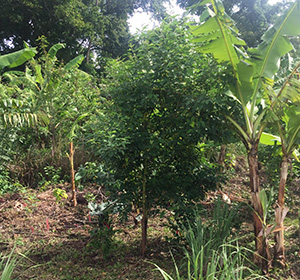
Ahrar, red gram, and frijoles gandules are just a few of the many names this versatile plant has. Whatever you call it, pigeon pea is easy to grow.
Native to tropical climates, these plants are perennial shrubs that grow from 6-12 feet. They grow best in US zones 9- 15 as they can’t tolerate frost.
But if you live someplace colder, you can try growing them as an annual.
How To Grow Pigeon Pea
One of the wonderful things about pigeon pea is that they can grow in just about any soil conditions. You can plant pigeon pea in poor, overused soil, and they will grow.
Related: How to Adjust the pH in Soil and Water for Abundant Harvests
While they obviously do better with more nutrients and regular water, the plants can survive drought-like conditions once established, making them a perfect survival plant.
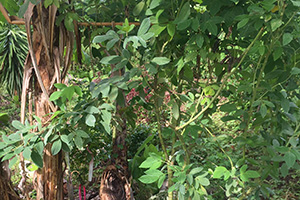 Pigeon pea can be grown directly from seed. Dig a hole 6-8 inches deep and plant 1-3 seeds per hole. Cover with a bit of soil but don’t fill the hole completely. You want to leave about 6 inches of space between each hole. If you plan on planting them in rows, you should space them 1-2 feet apart.
Pigeon pea can be grown directly from seed. Dig a hole 6-8 inches deep and plant 1-3 seeds per hole. Cover with a bit of soil but don’t fill the hole completely. You want to leave about 6 inches of space between each hole. If you plan on planting them in rows, you should space them 1-2 feet apart.
Make sure you water them thoroughly when you plant them. After that, you only need to water them once a week.
It takes two to three weeks for the plant to germinate. After that, they grow quite quickly. You might begin to see flowers in just two months.
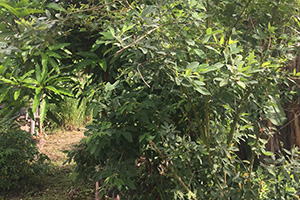 Once pigeon pea has become established in your garden it is prone to self-seed. So, give some thought to where you want to plant your pigeon pea. They can be grown in hedges and used windbreaks. Don’t worry if you wind up with too many, I’ll tell you all about what you can do with it.
Once pigeon pea has become established in your garden it is prone to self-seed. So, give some thought to where you want to plant your pigeon pea. They can be grown in hedges and used windbreaks. Don’t worry if you wind up with too many, I’ll tell you all about what you can do with it.
You can also plant them around young fruit trees to help protect the trees as they grow.
They will help shade the tree and as you prune your pigeon pea shrubs they will fertilize the tree, which I’ll explain more in a bit.
Harvesting Pigeon Pea
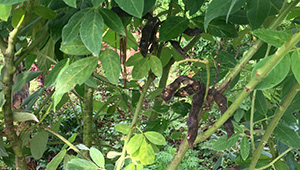 One of the obvious reasons to grow pigeon pea is that it is an edible crop.
One of the obvious reasons to grow pigeon pea is that it is an edible crop.
After the shrub flowers, it will produce pods.
Inside these pods, you will find four to five edible beans.
You may begin to harvest pods from your shrub in as little as three to four months.
However, depending on the variety you are growing, it could take as long as eight months to harvest.
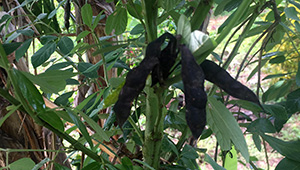 You can pick the pods green and enjoy the green beans inside fresh. They are similar to peas. Don’t worry if you find you have more pods then you can eat fresh. You can leave the pods to dry on the shrub. When they are dry you can harvest them in large bunches.
You can pick the pods green and enjoy the green beans inside fresh. They are similar to peas. Don’t worry if you find you have more pods then you can eat fresh. You can leave the pods to dry on the shrub. When they are dry you can harvest them in large bunches.
Cook these like you would any other dried beans. You’ll find many regional dishes that use pigeon pea.
Related: How to Dry Can Beans and Rice for 20+ Years Shelf Life
From Caribbean-style rice and beans to Indian Dahl with lentils there is sure to be a way you can enjoy these nutritious beans.
A Classic Caribbean Recipe
There are many different ways pigeon peas can be cooked.
A classic Caribbean recipe, Arroz con frijoles gandules is a variation on beans and rice. There are many variations to this dish but here is a basic version starting with a sofrito.
This nice hearty dish can be served on its own or you can add bacon or country ham to it.
Ingredients
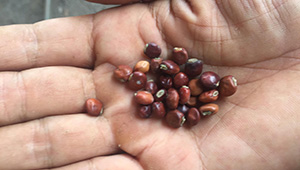 1 tsp oil
1 tsp oil- ⅓ cup sofrito
- 3 cups of chicken broth
- ⅓ cup tomato sauce
- 2 cups of pigeon peas (if dry soak overnight)
- 1 cup of rice
- Salt to taste
- Bay leaves, dry oregano, other seasonings (optional)
- Sofrito
- 1 onion
- 1 tomato
- 4 cloves garlic
- 2 green peppers
- 2 red peppers
- one bunch of Cilantro
- one bunch of Parsley
Instructions
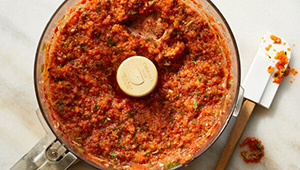 1. First, make the sofrito. Chop the ingredients small enough they fit into your food processor or blender.
1. First, make the sofrito. Chop the ingredients small enough they fit into your food processor or blender.
Then blend to a paste. You can store the remainder in the fridge or freezer for later.
2. Place a large stockpot of medium heat.
3. Add 1 tsp of oil and then the sofrito. Saute the sofrito to release the aroma.
4. Add the tomato sauce and stir to combine.
5. Next, add the chicken broth. Bring to a boil.
6. Add the pigeon peas. At this point, you can add other salt and other seasonings if you wish.
7. Wait for the liquid to return to a boil and add the rice. Stir to combine the rice and pigeon pea.
8. Cook until most of the liquid has been absorbed. Turn down the heat. Cover and steam for another 20-25 minutes. The rice should be light and fluffy and all the water should be absorbed.
Other Pigeon Pea Uses
While pigeon peas are healthy and delicious there are many other uses for them. Which is good- because as I said, once established they can spread prolifically.
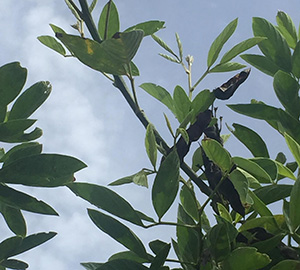 Pigeon peas are not only good for people to eat- they also make great animal fodder. If you have chickens, they will eat the whole plant. Leaves, flowers, stems, and seeds can be fed to your animals.
Pigeon peas are not only good for people to eat- they also make great animal fodder. If you have chickens, they will eat the whole plant. Leaves, flowers, stems, and seeds can be fed to your animals.
Not only do animals love pigeon pea bees do too. The flowers attract beneficial pollinators to your garden, that will help all your crops.
Pigeon peas can help your garden in other ways as well.
I mentioned you can plant pigeon pea even in your worst soil but it is even better than that- pigeon pea can help you rebuild your soil.
First, you will find that pigeon pea has a deep taproot that helps break up hard packed soil. But there is something even better than that.
Pigeon Pea, and other beans, belong to a class of plants that are often referred to as “nitrogen-fixing.” This means they help trap nitrogen from the air back into your soil, where it can help feed your plants.
Related: Get An Unlimited Supply Of Beans Growing This Tree
To benefit from this, you need to chop your pigeon pea back before they flower. Otherwise, the nitrogen will go into those seed pods (which makes them super healthy for us).
If you chop more than your animals can eat, pigeon pea makes great mulch or green compost. It’s just one more way pigeon pea can help improve your garden. You can also burn the wood as firewood.
Final Thoughts
Pigeon Pea is a great survival crop for anyone living in a warm climate.
Even on poor land, this plant can provide a bounty of food for you and your animals. And not only that, it helps improve your soil making it healthier for you to grow more food down the line.
And if you find yourself with too much, it’s great for mulching and building compost. How much more can you ask from one plant?
You may also like:
 How Much Ground Can You Cover Each Day Walking with Your BOB?
How Much Ground Can You Cover Each Day Walking with Your BOB?
What Happens If You Put Onions In Honey (Video)
Meal in a Bag: Chili with Beef and Beans

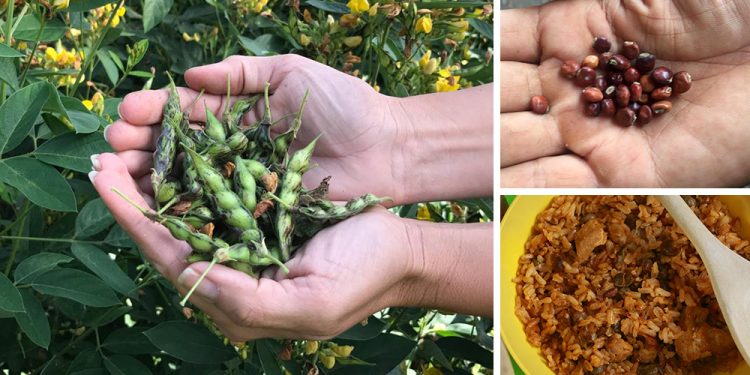













Thanks for the information on growing food. I feel the majority really lack that focus and drive to grow food for themselves… (its just not as a cool as buying a junk 1911) and talking about it over and over.
Thank you, We had some great success with ours this year and even grew some pumpkins.
I thought this was a very well done article!
I love carribean foods, most are a bit spicy for me, but I adjust.
Peas and rice are really good and easy to make. As she stated in the article, the sofrito is key!!!
Love the fact she added the recipe. Need more like this. Thanks again, Rachael.
Peace
MadFab
An interesting article, over at tropical permaculture (dot) com you can read it almost word for word again with much more details.
Needs WARM Soil to germinate or it rots in the ground. Need 3-4 months before you get a crop.
I am in NH and grow zone 5a so by the last frost and time the soil warms enough to germinate I have maybe 85 days before the first frost. So no Pigeon Peas for us.
Best grow zone Zone 9 and warmer.
For colder areas than Florida planting cow peas (black eyed peas or crowder peas) or simply any beans-peas will give you food, fodder for critters, Nitrogen improvement for your soil AND BTW Snip:
All parts of the pea plant are edible. As the pea leaves and stems mature, they tend to get tough and stringy, but when they are young, the pea shoots are not just tender, they are also crisp and tasty. They have a pea-like flavor, but even fresher.
Eating bean leaves
Younger leaves taste better, but older ones are perfectly edible too, and definitely fine for dehydrating. …
I need to harvest them all summer for this. These are going to do really well, and I need to consider bean leaves a crop in and of themselves, …
Young fava leaves taste excellent, kind of like the pod parts of edible podded peas. …
As a side note I sneak in pea and bean leaves into my soups and stews by dehydrating them and powdering them. Easy to do and adds nutrition in the winter.
So Don’t Despair if your not growing your survival garden in Florida. Good old peas and beans will do the same job aside from maybe small firewood sticks (but then again every storm I have PLENTY of that).
Michael: I’m in Arizona, Zone 9 A and will try them. I have moringa, but that’s iffy here and one will be brought into the house for winter. I prefer perennials and hope this is good, and good thru our savage winter. Yes, it really does get cold down here! Why do you think we put Christmas lights on the orange trees? they shiver so badly… 🙂 Apparently, the ‘peas make good houseplants. Cabbage family, I can grow everything but cabbages. We’re big on kraut and freeze a lot of it, but so far, none in the gaden have headed up. I’ve been asking family how Mom did it but no one remembers. Happy winter! (We’re hoping for snow this winter. those creeps up in Oracle (1,000 feet higher in elevation) hog it all…Of course watching artsy kali-fornian liberals try to drive in 10 inches of it can be interesting!) niio
Pigeon pea was discovered by Foodies a couple years ago, my California niece says they are her favorite, even better than the organic heritage pinto beans I send her. Black eye peas are similar to pigeon pea but are an annual and, to be honest, taste kind of like dirt. But if you are a novice gardener you can get a lot of nutrition growing blackeyes and yellow squash, both easy to grow. Probably going to try pigeon pea as an annual, got to keep niece happy.
Judge: dirt? Agreed! I raise yori cahui ‘peas for green beans. The major difference between them and green beans is they’ll grow here, LOL, and don’t get mushy when cooked. Reminds me, got to start 5 lbs dry pintos. They freeze well when cooked, and I like them to make soy sauce (and use rice, not wheat). niio
Claude:
I would suggest Moringa to everyone. It is a plant that contains a complete amino acid profile. It grows fast, anyone can grow it, it grows outside, inside or in a container and almost all parts of the plant can be used. There is no waiting for a vegetable or fruit to grow and ripen, moringa leaves can be harvested at any time. Fresh or dried leaves can be consumed or added to any dish. The nutritional profile for Moringa shows that it is truly a superfood. I grow it and consume some every day.
I tried growing moringa in Western Illinois. Did not do well at all. In fact never flowered and never made any seeds. Best plant only got to be 3 1/2 ft tall. Was very disappointed. Black gumbo is the main soil type around here. Corn and soybeans all around.
Where can I buy these seeds to plant?
SL are you asking for Pigeon Pea seeds OR Moringa seeds?
Both can be found in a few seconds by typing the name in the search engine of your choice.
Sommer: I got mine on Etsy. Moringa, got seeds for that at Baker’s Creek rare seeds. niio
Can these seeds be saved for long term storage for use when SHTF ? I would like to let them dry and then seal them in vacuum packs.
Donald as a Gardener I STRONGLY suggest you actually buy and PLANT the seeds your planning to use when the Grocery Store is a smoking ruin.
Gardening is FAR MORE than digging a little hole and planting seeds.
Far better to get your skills up NOW while you can spend some fiat money at the Grocery Store or restaurant of your choice for a meal than wait until your Forced to Garden for food.
Root Hog or Die means most are going to starve. Just saying as a History Buff.
Where do we get seeds to grow these plants from?
Moringa, baker’s creek rare seeds. Pigeon peas, I found them on Etsy. If you live in a hot, dry area, looks for Porter’s Improved tomatoes. They were bred for climates like W. Texas and my Arizona. niio
Stockton Reeves, I live in San Diego County in an area that is Zone 9 on the old maps, Zone 10 on the new maps, gets about 10 inches of rain a year and has a lot of 80-90-100 degree periods from May into November, often with fairly strong winds, including the hot and extremely dry Santa Anna winds, so additional watering is required for the vast majority of plants I grow but can also cause root rot and other problems if overdone.
I have 9 Moringa in 5-gallon buckets I grew from seeds, my wife got some seeds from a friend, and I also bought some on Etsy, and during the first year they grew okay and started flowering, and even produced some seed pods, wintered over very well, and during this second year the Moringa, still in 5-gallon buckets, are starting to “bush” more, flowering quite a lot which attracts both bees and hummingbirds, and my wife goes out and picks leaves whenever she wants. I have been pinching the ends of the growth stems, the tops at about six feet high, side branches when they get too heavy and bend over to much, to try and get them to bush out and produce more leaves. When the seed pods started developing this year I was pinching those off when about 1-3 inches long so the plants energy would be directed more towards leaves and flowers, and also seems to promote more leaf growth. This year I am letting one seed pod per plant grow to maturity and continue pinching off all other pods as soon as I see them when they are about 1-3 inches long. It’s the middle of October and it is cooling off some, but we are still getting 80-90 degree days, so the Moringa are still producing new growth and flowering. I expect them to winter over again and produce even better growth during year three, still in 5-gallon buckets.
Why keep them in buckets instead of transplanting to open ground? We are inundated with gophers that eat almost everything edible I plant in open ground, and I do not want to poison the gophers in case any dogs, cats, or predators eat them, so for now I stay mostly with container gardening. I do have one lemon, one orange, some Swiss Chard, green onions, and Amaranth growing in open ground that the gophers have not destroyed yet, but they ate everything else, including eating the roots out from under my Calamansi tree.
I saw several different varieties of Pidgeon Pea seeds available online, so if I wanted to try to grow some in both containers and open ground, what variety(s) would you recommend?
https://www.bing.com/shop?q=pigeon+pea+seeds+for+sale&FORM=SHOPTB
How do the beans taste off the moringa? One bloomed this year, but no beans. Thanks to the drought and people spraying them, a lot of wild bee hives died out in the area.
I sent for pigeon pea seeds. My only take on them was canned and it wasn’t pleasant. But, if it can winter over here, I’ll go for it. niio
red, I’ve read that all parts of Moringa are edible, so I asked my wife about eating the “Malunggay” / Moringa seeds and roots, and she said where she is from they only ate the leaves so does not know how to make the seeds or roots edible. The mature Moringa seeds on my little trees grow in large pods up to three feet long and about an inch in diameter, but are not really like beans or peas, they are very hard shelled with three fiber type “wings”, and I had to use the damp paper towel technique to get some of them to sprout. I guess I should research how to prepare the seeds as food and then try some. If they are good to eat then I can honestly say my Moringa’s will produce a lot of seeds if I do not pinch off the pods, maybe more in total weight and calories than the leaves.
red, I saw this article (link below) on the internet about eating Moringa, and it includes some information about eating the pods and seeds, both raw and cooked. I have a bunch of leftover moringa seeds from last years so I just cracked one open – the shell is not as hard I expected – the seed inside was white and about the size of a pea, has an odd sweet taste mixed with a very bitter background taste that gets stronger the more I chewed and continued after swallowing for an extended bad after taste to the point I would not recommend eating the dry seeds raw. This would definitely be an “acquired” taste, like eating bitter melon. My wife eats bitter melon, I don’t. I may try eating a fresh raw seed to compare, and also try cooking the moringa seeds such as the popcorn method mentioned in the article. I have been pinching off the very young pods when they are a few inches long and tossing them in the compost, but these may instead be good as a green supplement to add to soups and similar dishes. I’ll try eating a freshly picked young pod raw, and also add to a dish and let you know how those turn out.
https://www.doctorshealthpress.com/general-health-articles/moringa-seeds-benefits/
dz: when small, they taste sort of like green beans. Roots, donno, but some people can’t handle it. some have died after eating it. Leaves are added to anything being cooked, and only wilted like purslane. I was told cooking destroys the bitterness in the seeds. niio
red, I just pinched off three young pods from my Moringa’s, took a bite and chewed up a small piece of each, and they taste similar to a raw green bean, but the third pod also had a sort of spiciness to it, sort of like a bell pepper but not in a good way. For now I’ll stick to eating the leaves and continue to compost the pods and stems. I may let a pod grow longer and try a bite to see if the flavor changes as they get bigger.
My gardening learning curve keeps getting bigger, the more I learn the more I realize there is way more that I still do not know – yet. Working on it.
dz: cook some like beans. One planted in the garden bloomed well, but no beans formed. If it survives winter, they’ll all bloom.
Meanwhile, the mountain papaya is still trying to bloom, but tho its supposed to be self fertile, no fruit. this variety, oak leaf, is supposed to be hardy into zone 8 A. I have a cutting from a babaco papaya that’s showing new leaves. These two are from up to 8,000 feet in elevation in the Andes. niio
red, several months ago my wife brought home a papaya from the produce section and I don’t know what variety it is, nor do I have any experience with papaya, but I saved a lot of the seeds, let them dry for a couple weeks in a kitchen window, then sprouted and planted about 15 into smaller 2 gallon containers outside – they all died off in July from the windy dry heat, so I tried again but this time used a rectangle of some fine mesh window screen as shading and four have survived this time, are now from 4-6 inches tall, are very green with a lot of new growth, including new leaves sprouting along the main stem. I read you need three papayas to ensure you have at least one male and one female to produce fruit and will sometimes will fruit the following year, but sometimes don’t start fruiting until the second year. It is now the middle of OCT and is still warm during the day, usually in the 70’s but can get into the 80-90’s, with temperatures dropping into the 40-50’s at night. We are still getting periods of gusty winds that last for several days that often blow over several of the taller and more top heavy containers such as my tomatoes and asparagus beans. I do not bring plants inside for the winter so if the papayas survive and thrive I’ll know a lot more by Oct next year. I may keep sprouting and planting seeds to see if the cooler weather will help get them established, then survive through the winter since we rarely get frost here in East San Diego County zone 9 / 10.
Last week an elderly lady who lives about five miles from us and has several long established fruit trees gave my wife a lot of fruit like Manila mango’s, guava, dragon fruits, and goji, and also a 1 foot tall guava tree in a 2 gallon pot, and some dragon fruit cactus cuttings in a planter that they had grown themselves. They have survived my care for over a week now and have not shown any stress, so hopefully they survive, thrive, and eventually produce fruit. The six mangos were excellent, better than any mangos we have purchased from the grocery outlets or fruit stands, so I removed the seeds from the husks, and while still fresh planted them in small starter pots, with the top edge about 1/4 inch above the soil (the same as for avocado seeds), in a semi-protected area with partial shade. My previous attempts to grow mango trees have had more failure than success and it seems the two very young trees I have gotten to survive (so far) were from fresh seeds not allowed to dry at all, that had the top edge exposed when planted, and the containers placed in semi-protected partially shaded areas.
red, I had no prior experience with Moringa, not growing, eating, or even living in an area where they were being grown, so now I’m in my second year of learning about Moringa. I have nine Moringa in 5-gallon buckets and I think they all started flowering a little during the first year, and I let the pods grow to maturity and collected quite few seeds. I do not know if they are self pollinating or not. During this second year I tried to “companion” plant some zucchini and melons in a couple of the Moringa containers and those all stunted, dropped their leaves, and did not flower, but the others in containers all by themselves have a lot of new growth, have been flowering since Spring, then kind of went dormant and some leaves started yellowing when it was hitting 100 degree windy dry periods from July into Sep, but are now producing new growth, flowering, and producing seed pods again. I removed the zucchini and melons and those Moringas are starting to produce new growth again, but are definitely stunted compared to the others I also had a Malabar spinach vine growing alone in it’s own pot that spread out and wrapped around one Moringa, also stunting it, so I unwrapped and moved the Malabar, and that Moringa is also recovering. The stunted Moringa are about four feet tall and I have not pinched the top growth of those, and all the unhindered Moringa were “pinched” when the tops grew to as high as I can reach, which is about eight feet, so the Moringas are all about 6-7 feet tall (the 5-gallon buckets are about two feet tall), and I still have to keep pinching the new growth to keep them shorter so my wife can reach the leaves to harvest. Currently my goal for Moringa is to try to get them to produce more leaves for eating and only let a few pods mature to seed.
dz: You know the old saying the doctor is only there to entertain the patient. The papaya female, but a mountain oakleaf, and those are supposed to have perfect flowers, to be self-fertile.
Papaya hate two things, the wind and dry air. The oakleaf is alive, still trying to bloom, and it will stay in the tub on the south side of the house.
I can’t grow dragon fruit. They from the C. American lowlands. We do have 7 cereus, the Peruvian tree cactus type. Saguaro is a type of apple cactus, but all those around here are on private land. Moringa is the one thing safe from ground squirrels. One bite of root and they avoid them like the plague.
Another thing I know works is take pest insects or a dead ‘squirrel, drop them on a fire ant nest, give the nest a few hits with a stick, then run. From then on, fire ants will attack any of them. niio
dz: I have had great success trapping gophers. You need two traps. Find the run. I have talked about my shoji-zue, the ninja weapon of mass destruction that I use to locate a run. I dig into the run and expose both sides of my excavation. I set a trap about four inches from the opening on each side. I have a light chain attached to the trap so if the gopher isn’t instantly killed it won’t drag the trap back into its run and I might have to do a lot of digging to find it. The non-trap end of the chain on one trap is stapled with heavy duty staples to a chunk of wood. The other chain I have a long nail stuck through a link and I hammer that into the ground. In the summer our ground here, also in SoCal is like concrete, so the nail is almost a permanent fixture. On a couple of rare occasion I missed getting the gopher the first day but eventually got it because they cannot abide an opening in their run. Make sure the jaws of the trap face into the run and not into the opening that you have made.
I got rid of a colony of ground squirrels that liked to come into my business. The women didn’t like going in the restroom and finding a squirrel sharing the facilities with them. I used a .177 Daisy Powermaster pump up pellet gun with a low powered scope on it. I did this downtown. I put celery out as bait. I shot the ground squirrels close to their den so that they would run back in the den and die. I only had to kill about four or five before the rest of them just up and moved out somewhere else. I shot them from inside my plant so that the sound of the pellet gun would be muffled. Took shots when nobody was walking by. GAMO now makes a .177 pellet gun that is ultra quiet. I could probably shoot it outside my plant and nobody would have heard it. If your plot is isolated enough you might look into a pellet rifle. It was my unsubstantiated opinion that the reason the other ground squirrels left the den was because of the dead squirrels in the burrows. I think they interconnected and couldn’t stand the smell or something. Just a guess. Otherwise no real reason for them to move.
If you have a gopher colony, you might try leaving the dead bodies in the burrow. Gophers may have the same aversion to dead bodies if that were the reason why the ground squirrels moved to another neighborhood.
I tried to use the pellet gun on rats that were coming into our yard from a neighbor’s ivy patch. I didn’t have good luck with it. Too many shadows in the yard to make effective use of the scope and couldn’t see the rat well enough with iron sights to make accurate shots. In addition, this little buggers move a lot faster than ground squirrels. I used rat traps and peanut butter to good success.
You might also try rat traps and celery for the gophers. They eat veggies as their natural diet. I picked celery because it has a strong odor and didn’t wilt too much in the sun when I used it as bait for the ground squirrels.
On the other hand, you can view the gophers as EMP food on the hoof so to speak and keep them around in case of really hard times. Some folks are predicting food shortages a la the start of the plague. Roast gopher might look mighty attractive if things get tough enough.
Of course you might want to practice your shooting or trapping skills beforehand so that if hard times come, you will already be expert in harvesting gophers. A pellet gun is also handy for taking other small game and as silent as the GAMO is supposed to be you won’t be announcing your hunting to the whole neighborhood. Should be able to take pigeons nicely with a pellet gun.
LCC, I live in a cul-de-sac of a bout a dozen postage stamp 75’x90′ lots and I have successfully used gopher traps baited with peanut butter, but no matter how many gophers I kill they keep moving in from the surrounding lots. I am also hesitant to use the pellet gun to shoot gophers because 1.) the gophers rarely emerge above ground, usually at night, and I do not have the time to stand a watch waiting for them to emerge, and 2.) even though my neighborhood is fairly conservative, all it takes is one person to call in a complaint and then I would have to deal with law enforcement, maybe including the “red warning law” effect such as unlawful search and seizure of all firearms on the property even if owned by other family members.
At this time it’s not worth the time or effort to trap gophers, and is why I am planning on installing (burying) 1/2″x2′ galvanized hardware cloth as an upright vertical underground perimeter fence completely surrounding a 20’x30′ area, then trap any gophers that remained within the perimeter, and see if that will keep them out enough to grow vegetables in open ground that will survive long enough to produce edibles. I have a 2’x12′ “raised bed” that was also being raided by gophers until I used some 1/2″x3′ hardware cloth laid flat about two feet down as a horizontal underground barrier, and I have been able to grow zucchini, bak choy, okra, Chinese cabbage, green onions, and oregano in this planter this year and have not lost anything to gophers after barricading with the hardware cloth, but the slugs and other insects are still a problem for the green leafy vegetables, as well as bolting and/or getting cooked from our summer weather. I may try some cornmeal for the slugs and netting for the other insects, but insect netting will also keep the bees from pollinating so it will have to be used only for the vegetables that do not need to be pollinated. I will try growing cooler weather vegetables like broccoli, carrots, green beans, bak choy, and kale/lettuce in this raised bed over the winter and see how they fare.
LCC, funny you should mention the gophers as EMP food, I have joked with the wife that when the shelves are empty and we run out of our stored meats we can always eat the gophers, sort of like underground squirrels with very short tails. I would be concerned about parasites and diseases they might carry but if it came down to eating gophers or starving, then gopher cooked very well done will definitely be on the menu. I also told her about trapping wild birds to eat as well. We do not get pigeons around our home but there are a lot of wild doves, “songbirds”, and even crows that come around to check out my container garden. I will trap and eat any of them before I starve.
Used to know a Vietnamese man in Kali. He worked at a local school doing the yards.. he took the fresh gophers home for wife to make a stir-fry. He loved them..
dz: If they taste like groundhog, I’m in. I know one thing they hate. when I find a burrow, it gets used to dispose of dog wastes. Pack it in and soak it with the hose. Kitty litter, too (no reference to Miz Kitty’s house–I don’t need her coming to call with a baseball bar ! 🙂 provided it’s not a food garden. Dead snakes, very good. The smell of a predator will chase off female rats and males follow. To cut back on chance of a plague, AZ Game and Fish dropped cotton balls in a prairie rat town. They never told locals that black plague was killing that colony. The cotton balls had a pesticide in them that kills fleas and ticks. Had anyone known, the ‘rats would have been blown to kingdom come. niio
OK. this article was so good, I sent for pigeon pea seeds. while the problem with peas is, they do not like getting transplanted, I’ll still try a few seeds in January and plant the rest in March, close to summer here. Our major pest here is, other than the pup, Termite, sowbugs. While the soil is rich enough to support them and us, they eat seeds and seedlings. When I make a new batch of beer, a cup or two will go into traps. I tried that before and caught a few. Best results seem to be black winter radishes and moringa. niio
I found dried Pigeon Peas on WalMart.com, they look like a variety of lentil, and are about $6.59 per 14oz bag, rather expensive for a legume compared to dry pinto beans that average about $1.00 or less per LB. I have sprouted, grown, and harvested small batches of black eyed peas, pinto beans, red kidney beans, black beans, white beans, and small red beans from packages of beans sold as food in grocery sections instead of as seeds. I bought a package of dried whole (not split) lentils to try and grown some of them as well, but that will be during the coming winter season, and then again next spring/summer for comparison.
I do not know if you can get Pigeon Peas sold as packaged food to sprout and grow, has anyone tried this?
https://www.walmart.com/ip/Goya-Pigeon-Peas-14-oz-Gandules-pack-of-6-14-oz-bags/189387000
I see gardening as essential as any other prep. Zone sometimes called 5 and sometimes 6a. But -10° is part of a normal winter. I’ve seen-20° nights.
We grow a Spanish pea bush that’s attractive, good chicken feed, pea pods are edible young or matured seeds are a favorite of the chickens.
I grow an assortment of peas and beans every year. I like peas as a cover crop on areas otherwise laying fallow. Revitalizes an are for gardening, gives me plenty of peas to can and dry. I spade them under 2 weeks before planting or leave through a season then gather the vines to add to the compost. I have left them as a cover crop and let my chickens clean them up.
clergylady, I totally agree, not only is gardening a healthy activity, but if you ever depend on growing food yourself it’s very wise to have the knowledge and experience well established before any crisis hits, including harvesting and storing seeds, and as many other ways to propagate new plants as you can learn. I also get cuttings from sweet potatoes, camote, mint, oregano, and some other vegetables and herbs and then get them to root in a glass of water. Rooting cuttings is a lot easier than trying to grow everything from seed. The rooted cuttings seem hardier and usually survive better than new seedlings that often get eaten by pests or can just dry up and die in one hot and windy afternoon.
I would like to learn how to propagate fruit trees from cuttings, and I tried the “air layering” method once on my lemon bush but the young branch did not root for me, so I’ll try that again next spring, as well as try dusting a few fresh cuttings in root hormone and planting directly into containers. After a lot of trial and error, I finally have a few very young lemon, orange, avocado, and mango tree’s, all grown from seeds I sprouted and are doing fairly well in five gallon buckets. I’d like to start a few more from cuttings taken from my trees that have proven to be tough enough to survive my errors as well as survive the environment, but I will have to research more to learn all the steps and timing required to make the attempt with a reasonable chance of success.
That’s all great for your tropical flatlanders. We, who live in zones 3/4, don’t have the option to plant this stuff. So stories such as this, don’t mean squat for us!!
Chad that’s why the comment section is useful. Some of us post things that DO work in colder areas.
If nothing else gives you ideas to research on the web eh?
chad: But do for most of us. In Arizona, there’s maybe one out of 5 articles on gardening that I can use. But, I like them all.
Lucky you, you can grow Indian Rice Grass. our soil is Ph 8.5 and adobe and it grows, but doesn’t thrive. We both can grow a lot of stuff but there’s tons I only wish I could raise. All harvester ants in Arizona are fire ants. And one colony can grow to tens of thousands in a season. All honey bees here are Africanized. A week ago up in Phoenix, an old man was almost killed by them. Hantavirus, rabies, the black death happen here, a lot. Game and Fish plants colonies of prairie rats where they can, and one colony lost half its members to bubonic plague before they stopped it with a pesticide that kills fleas and ticks. by law, they’re supposed to blow up any colony with it.
Do you read Countryside Small Stock Journal? It’s a great mag, and no, I don’t worry that it’s for you northerners. There’s a lot of prepping that’s published. niio
chad, I’ve heard greenhouses work great for the norther climates and some people even have lemons, oranges, and avocados that survive and produce fruit in greenhouses.
montana chad, please feel free to post information that applies to all preppers in all locations, environments, and situations. I can understand some frustration with articles, especially when authors tell you to go buy some remote property somewhere (only if you can afford it, and can keep squatters away), tell you to find natural water sources, and to gather lots of firewood and learn to use it for heating and cooking, which only works if you are in a more rural area that has both adequate CLEAN water sources and an abundant supply of trees. Where I live there are neither adequate natural water sources or trees, which means my prepping has to adapt to my conditions as I’m sure you adapt to yours.
This is a little off tropic but inasmuch as it also includes food, I thought I would post it here. A couple of articles ago I stated that part of the problem with the Port of LA and the Port of LB was that hours for tucking had been curtailed to cut air pollution. Here are some additional reasons that I know are true from reading about bills signed by the goobinator of the PDRK:
The rest of the story
The NEWS says the California port situation is caused by a driver shortage.
NOT SO FAST: It is in part caused by a California Truck Ban which says all trucks must be 2011 or newer and a law called AB 5 which prohibits Owner Operators.
Traditionally the ports have been served by OWNER OPERATORS (non union). California has now BANNED Owner Operators.
Long term, truckers in California are not investing in new trucks because California has a law that makes them illegal in 2035. The requirement is to purchase electric trucks which do not exist.
The Media conveniently leaves out that the problem stems from California Democrat Regulations. The prices keep getting higher for truck drivers to do business in California. You can thank Goobinator Gabby Nuisance and the idiot liberals that don’t know where their food and other essentials come from that keep voting him into office. So when you are in empty grocery stores fighting over rationed essentials and food remember who ran the truck drivers and small truck driving businesses out of California. Please wake up, America, before it’s too late.
Another article states that 40% of all imports into the U.S. come through the Ports of Los Angeles and Long Beach. Considering how much stuff comes from our BFFs, China and our other buddies, South Korea, Taiwan and Japan, Vietnam, Indonesia and India, I am surprised that only 40% comes through those ports.
On the political side, major trucking companies are trying to do something about the owner-operator B.S. I think the Supremes in D.C. have ruled on it but I am not positive about that — or maybe they just decided to look at the case. It is the same B.S. with Uber drivers and other private drivers. The taxi companies and the Teamster Union abetted by the SEIU which is the union representing all the goobermint employees in the state are the ones behind the Uber law. I haven’t read anything about it, but I suspect the Teamsters are behind the Owner-Operator law.
I wish now I had taken that job in Bisbee, AZ way back in 1963 or 64.Too soon old; too late smart.
this is an article from Homesteadsurvival.com about growing fruit trees in a desert climate. It says pomegranates prefer alkaline soil.
https://homesteadsurvivalsite.com/fruit-trees-you-can-grow-in-the-desert/
Pomegranates seem to grow nicely in my town. A fair number of folk have them in their yards in my neighborhood. We are just slightly outside the California coastal belt. One half mile from my house is where the coastal belt ends. We are on a hill side which is what takes us out of the coastal belt but we are not quite in the inland hotter n hell belt. Aside from a significant lack of rain, I think this little microclimate where I live has the best weather of anywhere in the U.S. While the lack of rain is a moderate inconvenience right now, I don’t know how long it will be until it is a major problem.
DZ: Thanks for your informative posts about your garden and how you have handled various growing problems in your garden. You have about the same situation as I have with handkerchief-sized urban plots. Two houses about a block from my house have the breeding grounds for gophers. I have my eye on them as they will be good hunting grounds if the end of the world arrives. We have two very large murders of crows in our neighborhood. They too will be good for hunting. The rock doves in our neighborhood never seem to exceed 15 in number. They are as good eating as any other doves, although not much meat on them. I suspect it is the large number of crows that is keeping the rock dove population down. One dove makes a snack for one. The .22 pellet gun will be good for doves and crows. In my youth, long, long ago, crows were hunted with .22 rifles. Now one must use a shotgun loaded with very expensive non-lead shot, so there is little crow hunting done in this state.
LCC, have you searched for ways to trap and snare birds as well as shoot them? Traps and snares are fairly easy and inexpensive make, and you should be able reuse the same traps and snare materials several times to catch birds and small game.
LCC: Crows or ravens? Ravens eat snakes and rats. Crows will, if they can small ones but are also a pest. niio
After thinking about what to advise a very broad mix of preppers about “what to grow” that would cover multiple environments and circumstances, I think it would have to be very generic advice about learning your specific conditions and then making decisions accordingly, such as…
The “best” survival crops for a prepper will the crops selected as determined by each persons own specific circumstances that have high nutrient content, are hardy enough to survive your conditions, will be relatively easy to grow and care for, will produce a lot of harvest for the time and effort, and can be stored for extended periods without electricity if need be. There are two different prepper circumstances to consider, “bugging in, and “bugging out”.
For “bugging in” and staying where you already are, the first “universal” crop that comes to mind are beans, like pinto, kidney, black eyed peas and such, and then you will have to determine which varieties are best for your specific environment.
The next choices would be root crops like potatoes, tubers, carrots, onions, garlic and so on, also selected in accordance with your specific conditions, hardier annuals like tomatoes, green beans, peas, zucchini, and peppers, and grains like corn and amaranth, greens like kale, spinach, bak choy, swiss chard, herbs both medicinal and for seasonings, and of course the squash and melons if you have the room and water. Fruits and berries should also be considered for long term growing and harvesting, but fruits usually take years of care and the correct conditions before they produce viable harvests. Research your conditions, and then select and learn how to successfully grow and harvest your own produce.
For “bugging out” and trying to decide what you should take with you, for seeds think “compact and hardy”. It will be a lot easier to pack a small container with dry beans and other dry seeds than to try to bring (and keep alive) any potted plants, but that will depend on how you are bugging out. If in a vehicle you may be able to bring a small potted fruit tree or starter grape and berry vines, and starter potatoes and tubers like sweet potatoes, but if traveling on foot you should probably stick to small (and light weight) compact dry seeds like beans, tomatoes, peppers, onions, spinach, kale, squash, and maybe some fruit tree seeds like apples, pears, figs, goji, and lemons, again determined by the conditions of the area you expect to settle down in – not for where you are from, but for where you intend to go.
dz: For this area, I always tell newbies, go to Native Seed Search, in Tucson, to see what does well. One thing that doesn’t here is corn. Farmers raised sorghum and that brought in dwarf maise virus. Because grass can feed the aphids that carry it, it’s endemic. But, I do keep trying and save seed from any that survives long enough to mature. niio
another article about growing fruit trees in the United States
https://thegardeningdad.com/best-fruit-trees-to-grow-in-the-united-states/
Unfortunately, this plant will not do well in my zone either, and I just don’t have room to consider it as a houseplant, but that doesn’t mean I won’t try the recipe provided by the author for Caribbean rice and beans. With a few substitutions, I am sure it will be a tasty side dish at any bbq or fish dinner and a good way to get adequate nutrition in an emergency. It’s an island staple worth adding to my culinary repertoire.